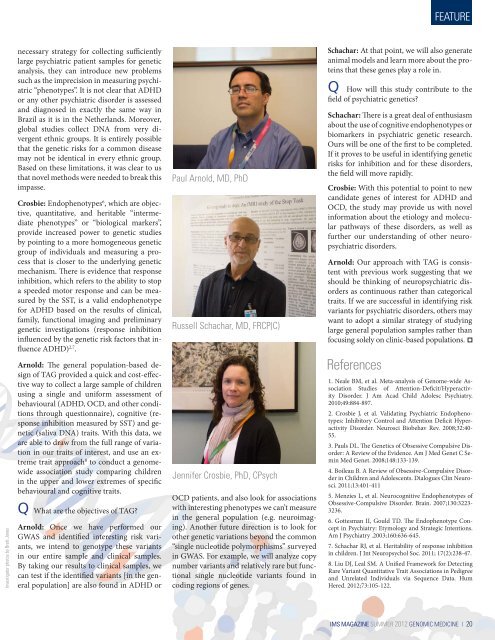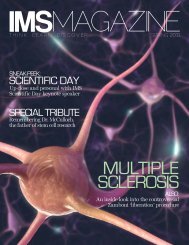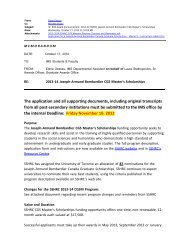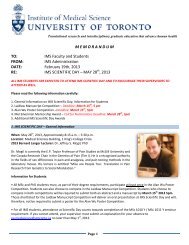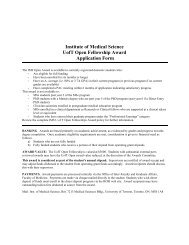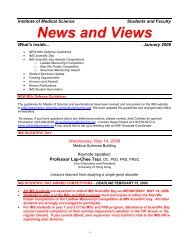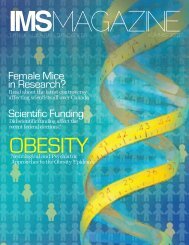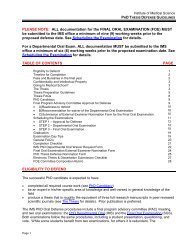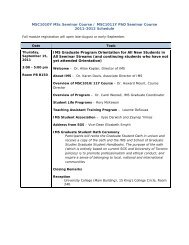IMS Magazine - Summer 2012 edition in PDF format - Institute of ...
IMS Magazine - Summer 2012 edition in PDF format - Institute of ...
IMS Magazine - Summer 2012 edition in PDF format - Institute of ...
Create successful ePaper yourself
Turn your PDF publications into a flip-book with our unique Google optimized e-Paper software.
FEATURE<br />
necessary strategy for collect<strong>in</strong>g sufficiently<br />
large psychiatric patient samples for genetic<br />
analysis, they can <strong>in</strong>troduce new problems<br />
such as the imprecision <strong>in</strong> measur<strong>in</strong>g psychiatric<br />
“phenotypes”. It is not clear that ADHD<br />
or any other psychiatric disorder is assessed<br />
and diagnosed <strong>in</strong> exactly the same way <strong>in</strong><br />
Brazil as it is <strong>in</strong> the Netherlands. Moreover,<br />
global studies collect DNA from very divergent<br />
ethnic groups. It is entirely possible<br />
that the genetic risks for a common disease<br />
may not be identical <strong>in</strong> every ethnic group.<br />
Based on these limitations, it was clear to us<br />
that novel methods were needed to break this<br />
impasse.<br />
Crosbie: Endophenotypes 6 , which are objective,<br />
quantitative, and heritable “<strong>in</strong>termediate<br />
phenotypes” or “biological markers”,<br />
provide <strong>in</strong>creased power to genetic studies<br />
by po<strong>in</strong>t<strong>in</strong>g to a more homogeneous genetic<br />
group <strong>of</strong> <strong>in</strong>dividuals and measur<strong>in</strong>g a process<br />
that is closer to the underly<strong>in</strong>g genetic<br />
mechanism. There is evidence that response<br />
<strong>in</strong>hibition, which refers to the ability to stop<br />
a speeded motor response and can be measured<br />
by the SST, is a valid endophenotype<br />
for ADHD based on the results <strong>of</strong> cl<strong>in</strong>ical,<br />
family, functional imag<strong>in</strong>g and prelim<strong>in</strong>ary<br />
genetic <strong>in</strong>vestigations (response <strong>in</strong>hibition<br />
<strong>in</strong>fluenced by the genetic risk factors that <strong>in</strong>fluence<br />
ADHD) 2,7 .<br />
Paul Arnold, MD, PhD<br />
Russell Schachar, MD, FRCP(C)<br />
Schachar: At that po<strong>in</strong>t, we will also generate<br />
animal models and learn more about the prote<strong>in</strong>s<br />
that these genes play a role <strong>in</strong>.<br />
Q How will this study contribute to the<br />
field <strong>of</strong> psychiatric genetics?<br />
Schachar: There is a great deal <strong>of</strong> enthusiasm<br />
about the use <strong>of</strong> cognitive endophenotypes or<br />
biomarkers <strong>in</strong> psychiatric genetic research.<br />
Ours will be one <strong>of</strong> the first to be completed.<br />
If it proves to be useful <strong>in</strong> identify<strong>in</strong>g genetic<br />
risks for <strong>in</strong>hibition and for these disorders,<br />
the field will move rapidly.<br />
Crosbie: With this potential to po<strong>in</strong>t to new<br />
candidate genes <strong>of</strong> <strong>in</strong>terest for ADHD and<br />
OCD, the study may provide us with novel<br />
<strong>in</strong><strong>format</strong>ion about the etiology and molecular<br />
pathways <strong>of</strong> these disorders, as well as<br />
further our understand<strong>in</strong>g <strong>of</strong> other neuropsychiatric<br />
disorders.<br />
Arnold: Our approach with TAG is consistent<br />
with previous work suggest<strong>in</strong>g that we<br />
should be th<strong>in</strong>k<strong>in</strong>g <strong>of</strong> neuropsychiatric disorders<br />
as cont<strong>in</strong>uous rather than categorical<br />
traits. If we are successful <strong>in</strong> identify<strong>in</strong>g risk<br />
variants for psychiatric disorders, others may<br />
want to adopt a similar strategy <strong>of</strong> study<strong>in</strong>g<br />
large general population samples rather than<br />
focus<strong>in</strong>g solely on cl<strong>in</strong>ic-based populations.<br />
Investigator photos by Brett Jones<br />
Arnold: The general population-based design<br />
<strong>of</strong> TAG provided a quick and cost-effective<br />
way to collect a large sample <strong>of</strong> children<br />
us<strong>in</strong>g a s<strong>in</strong>gle and uniform assessment <strong>of</strong><br />
behavioural (ADHD, OCD, and other conditions<br />
through questionnaire), cognitive (response<br />
<strong>in</strong>hibition measured by SST) and genetic<br />
(saliva DNA) traits. With this data, we<br />
are able to draw from the full range <strong>of</strong> variation<br />
<strong>in</strong> our traits <strong>of</strong> <strong>in</strong>terest, and use an extreme<br />
trait approach 8 to conduct a genomewide<br />
association study compar<strong>in</strong>g children<br />
<strong>in</strong> the upper and lower extremes <strong>of</strong> specific<br />
behavioural and cognitive traits.<br />
Q What are the objectives <strong>of</strong> TAG?<br />
Arnold: Once we have performed our<br />
GWAS and identified <strong>in</strong>terest<strong>in</strong>g risk variants,<br />
we <strong>in</strong>tend to genotype these variants<br />
<strong>in</strong> our entire sample and cl<strong>in</strong>ical samples.<br />
By tak<strong>in</strong>g our results to cl<strong>in</strong>ical samples, we<br />
can test if the identified variants [<strong>in</strong> the general<br />
population] are also found <strong>in</strong> ADHD or<br />
Jennifer Crosbie, PhD, CPsych<br />
OCD patients, and also look for associations<br />
with <strong>in</strong>terest<strong>in</strong>g phenotypes we can’t measure<br />
<strong>in</strong> the general population (e.g. neuroimag<strong>in</strong>g).<br />
Another future direction is to look for<br />
other genetic variations beyond the common<br />
“s<strong>in</strong>gle nucleotide polymorphisms” surveyed<br />
<strong>in</strong> GWAS. For example, we will analyze copy<br />
number variants and relatively rare but functional<br />
s<strong>in</strong>gle nucleotide variants found <strong>in</strong><br />
cod<strong>in</strong>g regions <strong>of</strong> genes.<br />
References<br />
1. Neale BM, et al. Meta-analysis <strong>of</strong> Genome-wide Association<br />
Studies <strong>of</strong> Attention-Deficit/Hyperactivity<br />
Disorder. J Am Acad Child Adolesc Psychiatry.<br />
2010;49:884-897.<br />
2. Crosbie J, et al. Validat<strong>in</strong>g Psychiatric Endophenotypes:<br />
Inhibitory Control and Attention Deficit Hyperactivity<br />
Disorder. Neurosci Biobehav Rev. 2008;32:40-<br />
55.<br />
3. Pauls DL. The Genetics <strong>of</strong> Obsessive Compulsive Disorder:<br />
A Review <strong>of</strong> the Evidence. Am J Med Genet C Sem<strong>in</strong><br />
Med Genet. 2008;148:133-139.<br />
4. Boileau B. A Review <strong>of</strong> Obsessive-Compulsive Disorder<br />
<strong>in</strong> Children and Adolescents. Dialogues Cl<strong>in</strong> Neurosci.<br />
2011;13:401-411<br />
5. Menzies L, et al. Neurocognitive Endophenotypes <strong>of</strong><br />
Obsessive-Compulsive Disorder. Bra<strong>in</strong>. 2007;130:3223-<br />
3236.<br />
6. Gottesman II, Gould TD. The Endophenotype Concept<br />
<strong>in</strong> Psychiatry: Etymology and Strategic Intentions.<br />
Am J Psychiatry .2003;160:636-645.<br />
7. Schachar RJ, et al. Heritability <strong>of</strong> response <strong>in</strong>hibition<br />
<strong>in</strong> children. J Int Neuropsychol Soc. 2011; 17(2):238-47.<br />
8. Liu DJ, Leal SM. A Unified Framework for Detect<strong>in</strong>g<br />
Rare Variant Quantitative Trait Associations <strong>in</strong> Pedigree<br />
and Unrelated Individuals via Sequence Data. Hum<br />
Hered. <strong>2012</strong>;73:105-122.<br />
<strong>IMS</strong> MAGAZINE SUMMER <strong>2012</strong> GENOMIC MEDICINE | 20


